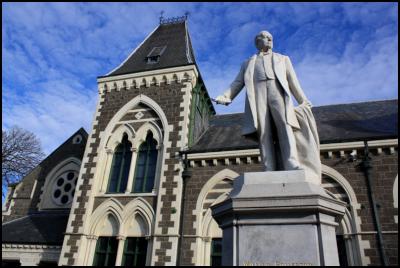Christchurch's education heritage recognised
17 March 2013
Christchurch's education
heritage
recognised
2013
International Day for Monuments and Sites – Thursday 18
April:
The Heritage of
Education

Cantabrians have long been proud of the region’s education heritage, but they have extra reason to pay respect to the city’s remaining historic educational treasures on Thursday.
Thursday 18 April marks world heritage day – also known as International Day for Monuments and Sites. This year the day, which is convened by the International Council for Monuments and Sites (ICOMOS), will focus its attention on the heritage of education.
The day takes on extra significance in Christchurch, which has a strong identification with its educational institutions, and is still recovering from the loss of much of its heritage after recent earthquakes.
New Zealand Historic Places (NZHPT) Southern Region General Manger Rob Hall says it’s more important than ever to celebrate the city’s remaining heritage.
“Despite recent events in Christchurch and the loss of so many of our heritage buildings a good number of the city’s original educational buildings have survived.
“From Cranmer Square in the north to St Michael's Church School (the city’s oldest school) on Oxford Terrace in the south, there remains a small precinct of Christchurch’s early educational buildings, which unless pointed out could be easily overlooked,” says Mr Hall.
Heritage consultant and chair of ICOMOS New Zealand Jenny May agrees.
“We do tend to forget about our educational buildings. But it is so unusual to have such a concentration of our colonial beginnings in one small area and they tell us so much about our social history,” she says.
Some of the city’s foremost and celebrated colonial architects designed these institutional buildings: William Armson, Thomas Cane, Collins and Harman, Benjamin Mountfort, George Penlington, Samuel Hurst Seagar and Cecil Wood.
The precinct included the Peterborough Centre which opened in 1930 as the Christchurch Teachers' College and in 1986 was converted into award winning luxury apartments; the Christchurch Normal School, later Cranmer Court, which housed New Zealand's first teachers' training college (1876); Cathedral Grammar (1863); Christ’s College (begun 1863); the Arts Centre (began 1876); the second Christchurch Girls’ High School, identified for over 100 years with the development of women's education in New Zealand; the Canterbury Museum (1870-1877) and the Curator’s House, built in 1920.
Although some of these buildings have been lost, they were a significant part of the city’s architectural as well as social heritage.
“They were very much built on what we would call Collegiate Gothic design with that institutional design in mind. They were recognisable institutions that said what they were and you treated them with respect,” says Jenny May.
To mark world heritage day, the NZHPT and ICOMOS New Zealand have planned two NZHPT members guided tours around the built heritage of Christchurch’s educational facilities on the western fringe of the inner city on Thursday.
More
information about New Zealand’s educational heritage can
be found online, visit the NZHPT’s Register of historic
places:
http://www.historic.org.nz/theregister.
Photo:
Statue of William Rolleston outside the Canterbury Museum.
Rolleston was instrumental in the establishment of the
Canterbury Museum and the Canterbury College, which now
houses the Arts
Centre.


 Health New Zealand: Community And Collaboration Bring New Mental Health Facility Garden To Life
Health New Zealand: Community And Collaboration Bring New Mental Health Facility Garden To Life NZBS: Turn Up The Music, Roll Up Your Sleeve - New Zealand Blood Service Drop The Beats For Donation
NZBS: Turn Up The Music, Roll Up Your Sleeve - New Zealand Blood Service Drop The Beats For Donation School Library Association of NZ Aotearoa: Students Missing Out - New Research Exposes Alarming Disparities Across Aotearoa
School Library Association of NZ Aotearoa: Students Missing Out - New Research Exposes Alarming Disparities Across Aotearoa ANZCA: Health Reforms Raise Fears Of Two-Tier System And Workforce Shortages
ANZCA: Health Reforms Raise Fears Of Two-Tier System And Workforce Shortages Māpura Studios: A Matariki Exhibition At Historic Alberton House
Māpura Studios: A Matariki Exhibition At Historic Alberton House Doc Edge Festival: Finalists For The Doc Edge Awards 2025, an Oscar®-qualifying event
Doc Edge Festival: Finalists For The Doc Edge Awards 2025, an Oscar®-qualifying event